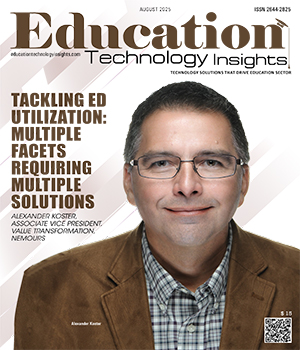THANK YOU FOR SUBSCRIBING
Be first to read the latest tech news, Industry Leader's Insights, and CIO interviews of medium and large enterprises exclusively from Education Technology Insights
Leading Learner-Centered Innovation in EdTech
Jennifer VanWagner, Educational Technology Manager, Ohio Northern University
Shaping Leadership and Driving Effective EdTech Initiatives Jennifer VanWagner, Educational Technology Manager, Ohio Northern University
Jennifer VanWagner, Educational Technology Manager, Ohio Northern University
My foundation in working directly with learners continues to shape every decision I make. Learners are the reason we exist in higher education and keeping them at the center of technology initiatives ensures I maintain the right perspective when leading change. Early in my career, I witnessed how the right technology could remove barriers to learning. Recorded lectures gave students a chance to review concepts outside of class, while poorly implemented solutions created new challenges, like not breaking lectures down by topic for easier digestion. This taught me that technology is never neutral and it either serves learners, or it doesn't. When exploring adaptive learning platforms or AI-powered tools, I consistently ask: "How does this genuinely improve the learning experience?" rather than simply "What's the latest innovation?" This learner-first lens has been instrumental in helping adopt technologies that truly make a difference rather than chasing trends for their own sake.
Two principles have proven essential: transparency and communication. Transparency means helping faculty and staff understand the "why" behind any adoption. Technology decisions are the result of committee discussions, cross-functional evaluations, and input from multiple stakeholders including faculty, students, and IT professionals. When faculty and staff understand that their colleagues helped shape these decisions, resistance decreases significantly. Communication goes beyond announcement; it's an ongoing dialogue about how the new initiative makes their work more sustainable and effective. When we implemented our latest LMS enhancements, we demonstrated how these features would save faculty time on routine tasks, allowing them to focus more on teaching and student interaction.
Integrating AI to Enhance Teaching and Learning
AI represents the most significant shift in educational technology since the internet itself. I see AI fundamentally changing three areas: personalization of learning at scale, augmentation of faculty capabilities, and transformation of how we assess learning outcomes. To prepare our community, I've developed a comprehensive AI course for faculty and staff covering practical benefits, responsible use considerations, and creative applications specific to their disciplines. We explore both possibilities and limitations helping everyone understand when AI enhances learning and when human judgment remains irreplaceable. I've also launched a 30-day AI challenge that moves participants from theory to practice, encouraging them to experiment with AI in their specific context whether that's a chemistry lab, a writing course, or administrative workflow.
“Communication goes beyond announcement; it's an ongoing dialogue about how the new initiative makes their work more sustainable and effective.”
My courses create structured opportunities for everyone from different disciplines to collaborate, share challenges, and exchange solutions. A biology professor might discover an assessment strategy from a business professor that transforms their approach. An English instructor might adapt a feedback framework from engineering. The courses have also helped everyone understand the pedagogical rationale behind technology and process changes, reducing the perception that "IT is forcing new tools on us" and replacing it with "We're adopting tools that align with our vision and mission."
Navigating Challenges and Future Trends in EdTech
The primary challenge is pace and capacity navigating unprecedented AI innovation, managing continuous system updates, ensuring adequate training, all with reduced staffing and resources. My approach combines strategic time management with systematic prioritization. I've structured my days to ensure no critical area gets neglected, preventing reactive firefighting while addressing immediate needs and maintaining strategic awareness. To address staffing challenges, I'm developing scalable support models: creating self-service resources, training faculty champions who can support their peers, and building communities of practice. I'm also being more strategic about which innovations we pursue not every new tool deserves adoption, and sometimes the best decision is to deepen our use of existing platforms.
Three interconnected trends will define the next phase: First, the ability to verify authenticity and evaluate AI-generated content will become critical. This isn't about "catching cheaters "it's about understanding how to assess learning in an AI-augmented world and helping students develop their judgment to evaluate AI outputs critically. Second, AI agent development will become a core competency. Future educational technologists will need to design specialized AI agents for specific educational contexts, requiring both technical literacy and deep pedagogical understanding. Third, we must maintain what I call "human thinking with AI review" the ability to think creatively, critically, and ethically as humans while leveraging AI as a powerful editing and analytical tool. We should position AI as a personal assistant or editor, not as a colleague who does our thinking for us.
Future leaders will need the ability to evaluate technology through a pedagogical lens; the emotional intelligence to lead change with empathy; the strategic thinking to distinguish meaningful innovation from hype; and the wisdom to know when human judgment and connection matter more than technological efficiency. The leaders who succeed will be those who can harness powerful new tools while keeping education fundamentally human-centered.
Read Also
Rewiring Stem Education for the Future
Redefining Student Engagement: Fostering Sustainable, Redemptive and Accountable Excellence For Holistic Student Growth
The Ripple Effect of Investing in Staff Development
Mental Health as a Foundation for Student Success
Balancing Innovation with Inclusivity to Transform Digital Learning Experiences
Building a Culture of Continuous Professional Learning

I agree We use cookies on this website to enhance your user experience. By clicking any link on this page you are giving your consent for us to set cookies. More info

However, if you would like to share the information in this article, you may use the link below:
www.educationtechnologyinsightseurope.com/cxoinsights/jennifer-vanwagner-nid-3518.html





















